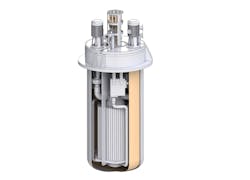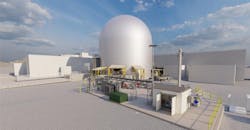Talk about Nuclear Fast Track: DOE Wants Operational SMRs by July 2026
While numerous small modular reactor nuclear startups are pursuing approval from the U.S. Nuclear Regulatory Commission on design and construction permits, the federal Department of Energy (DOE) is starting a new pilot program to expedite testing of advanced reactor designs under its direct supervision.
The DOE program would oversee pilot projects conducted outside of the national laboratories, such as Idaho and Oak Ridge, which also are doing small modular reactor (SMR) collaborations. The DOE pilots are in line with President Trump’s recent executive order on nuclear testing reforms.
“Our proud history of innovation has succumbed to overregulated complacency,” reads the introductory passage in the president’s executive order, saying that Idaho National Laboratory, the nation’s primary research facility for testing new reactor designs, has not constructed one since the 1970s.
In response, the DOE is issuing a request for applications seeking qualified U.S. reactor companies wanting to build and operate test reactors outside of the national laboratory process. Companies which already are working to move forward with advanced and SMR designs include Aalo Atomics, X-energy, TerraPower, NuScale Power, Oklo and Natura Resources, among others.
Aalo Atomics, which develops its designs from Austin, Texas and in Idaho, is working directly with the DOE. The company is buoyed by the array of President Trump's executive orders attempting to fast-track SMR, advanced and microreactor development.
"The DOE's new pathway reflects a growing recognition that our regulatory framework must evolve to match the pace of innovation," Aalo Atomics CEO Matt Loszak said in reponse to an emailed question from EnergyTech. "At Aalo, we're pursuing testing and demonstration through DOE authorization, distinct from the NRC route, because it allows for faster iteration, early feedback, and data generation critical for eventual NRC licensing.
"This dual-pathway approach is essential to unlocking the next era of advanced nuclear deployment in the United States," Loszak added.
SMR momentum growing under concern about future data center demand
Nuclear energy generates carbon-free electricity and currently provides about 18% of the nation’s utility-scale portfolio. SMR nuclear is seen as a path forward to deliver resilient, high capacity-factor power for the coming demand from artificial intelligence, growing digital infrastructure and expanded industrial electrification.
“The pilot program builds on current efforts to demonstrate advanced reactors on DOE sites through microreactor testbeds and other projects led by the Department of Defense and private industry, “ reads the DOE release about its new program. “It is specifically designed to foster research and development of nuclear reactors and not demonstrate reactors for commercial suitability. Seeking DOE authorization provided under the Atomic Energy Act will help unlock private funding and provide a fast-tracked approach to enable future commercial licensing activities for potential applicants."
SMRs, like all nuclear power plant projects, attract opposition from those who are concerned about safety and cost issues. Many conventional nuclear plants were being retired in the U.S. due to lack of economic competitiveness, but the looming data center demand crisis is creating the potential for reopening of Three Mile Island and possibly other sites.
Push to create operational reactors is moving Yankee Doodle Dandy fast
DOE will consider advanced reactors having a chance to operate by the July 4, 2026 deadline. While applicants will be responsible for all costs associated with designing, manufacturing, constructing, operating, and decommissioning each test reactor, they will be selected based on a set of criteria, including technological readiness, site evaluations, financial viability, and a detailed plan to achieve criticality.
This program is on the fast track, indeed: Initial applications are due by July 21, with subsequent applications allowed on a rolling basis. DOE will sponsor an Industry Day event on June 25, next week, which will include virtual and in-person attendance.
President Trump’s executive order posted May 23 followed his previous EO on his first day in office, January 20, which declared a “national energy emergency” while also at least temporarily freezing some spending on renewable energy programs. The earlier order noted that the U.S. needs a “reliable, diversified and affordable supply of energy to drive development of advanced technologies, manufacturing, transportation, agriculture and defense industries, and to sustain modern life and national security.”
The federal government under previous administrations, according to President Trump, has “effectively throttled the domestic deployment of advanced reactors, ceding the initiative to foreign nations in building this critical technology.”
Indeed, no SMR has yet started construction much less been completed and put into operation in the U.S, despite more than a decade of private development and financing work. Russia and China do have operational SMR nuclear plants, and other nations are working with design firms on developing their own projects.
In recent SMR nuclear news, the NRC has agreed to review a construction permit for Long Mott Energy to build a power plant energizing Dow Chemical’s manufacturing facility in south Texas. At the heart of that proposed plant would be four X-energy Xe-100 SMR reactors generating about 80 MW each.
The NRC timeline for considering and then deciding on the X-energy SMR plant is 18 months. Long Mott is a subsidiary of Dow, and the Seadrift manufacturing plant produces packaging and consumer goods.
Another microreactor startup, NANO Nuclear , is working with the University of Illinois Urbana-Champaign on a campus research project.








